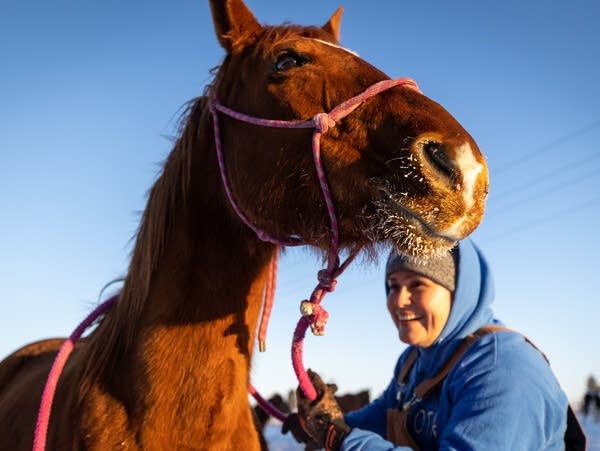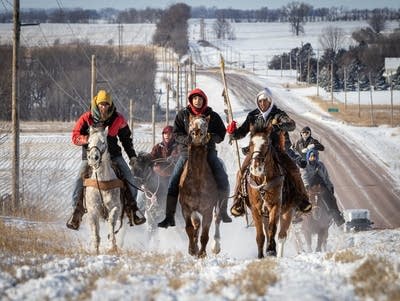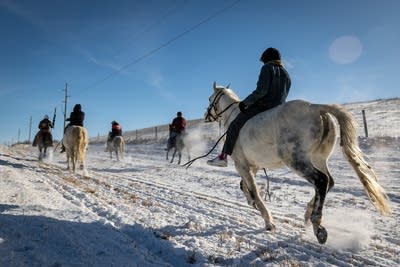Descendants of executed Dakota 38+2 ride to Mankato to honor ancestors
Dakota riders make last trip honoring ancestors, look toward hopeful future

Go Deeper.
Create an account or log in to save stories.
Like this?
Thanks for liking this story! We have added it to a list of your favorite stories.
It’s been a long, hard journey for the Dakota 38+2 riders. They tended to the horses, making sure they’re fed and watered at the Flandreau Indian School in Flandreau, S.D.
This was one of the few days in their 330-mile trek that riders get to rest in an actual bed and take hot showers.

But no one complained. LeAnne RedOwl, 41, of Santee, Neb., helped with this ride for over a decade. She is Isanti Dakota and a direct descendant of Marpiya Okinajin, one of the 38 hanged men. This journey, RedOwl said, has been her life.
“The first thing I ever heard was, every time your horse’s foot hits the ground is a prayer,” she said. “That’s the strongest thing because we’re in ceremony. We’re here with a purpose.”
Turn Up Your Support
MPR News helps you turn down the noise and build shared understanding. Turn up your support for this public resource and keep trusted journalism accessible to all.
The U.S.-Dakota War of 1862
That purpose is to maintain the memory of what happened during and after the U.S.-Dakota War of 1862. It started when Indian agents withheld food and supplies guaranteed under treaty with the Dakota people, part of an effort to force the Dakota off their land. Hundreds died in the war that lasted a little over a month.
More than 300 Dakota warriors were sentenced to death, but there was public outcry. Many religious leaders protested the executions to President Abraham Lincoln. He reviewed each case and reduced the number to 38.
About 1,700 Dakota people, mostly women and children, who weren’t sentenced to death or prison were removed from Lower Agency to Fort Snelling in November 1862.
On Dec. 26, 1862, 38 Dakota men were hanged in Mankato. It was the largest single-day mass execution in U.S. history. Lincoln signed the death warrants. Two more Dakota chiefs were executed two years later.
Many of the incarcerated Dakota women and children died of cold and hunger that winter. The impacts of the trauma continue to be felt today.

A spiritual leader’s dream
In 2005, Lakota spiritual leader Jim Miller dreamt of Dakota people on horseback returning home to Minnesota. The ride became reality in 2008 with descendants of the executed men in the group. It’s been repeated each December since.
Now, only four of the original riders remain, and they said this will be their last. So, they say the ride will end.
Josette Peltier of Flandreau, a Dakota elder and Miller’s sister, says the ride fulfilled her brother’s dream, and she’s seen people change over the years.
“I’ve healed,” Peltier, 69, said. “I’ve gotten a lot of healing from this ride. And, I’m really grateful that my brother had this dream because had I not come on the ride, I don’t think I would have been able to grasp my roots.”
However some hope the younger riders will take over, and the commemoration will continue.
‘You need to know their history’
Later that night, communities from all over came to a nearby senior center to show their support. Children and adults drummed together, singing in a send-off to the riders. There’s laughter, singing, eating and reunions of old friends. Many of the riders said this is the most young people ever at the ride, and they were heartened.
Pamela Byrd followed in the footsteps of her father, Sidney Byrd, an elder of the Flandreau Santee Sioux Tribe. He’d feed the riders while telling them the story of the 38+2. After he died in 2016, Pamela promised her father that she’d continue supporting the riders. She hoped the younger generations learn their history from the rides.

“It’s hard to accept sometimes what another person does to another person,” Pamela said. “You have to forgive, but it still hurts. And my dad says you need to know what the other person is feeling. You need to know their history.”
Then, riders got word that ride founder Jim Miller was at the hospital. So, they formed a circle and held a prayer ceremony for him.
Todd Finney, whose Dakota name is Ta Can’te Was’te Yuha Omani (He Who Walks With His Good Heart) is Miller’s nephew and one of the organizers for the ride. He said they will finish this journey and focus on reaching Mankato.
“I just want to honor my Uncle Jim. I want to make sure we do this,” Finney said. “We’re praying for him in everything that we do, because he is such an amazing human being because he created this movement. So, even though this chapter may end, the things that he helped plan, the things that he helped do, are gonna just keep continuing.”
‘We are still here’
The next morning, the riders of all ages saddled up and headed toward the Minnesota border. A caravan of trucks, trailers and cars followed along.
Beneath an open blue sky, the prairie glistened with ice and snow as the riders made their way to Pipestone National Monument.

It was a homecoming. Drummers played while singing, and the horses galloped and circled four times before coming to a stop before ending this part of the ride in prayer.
LeAnne RedOwl, Isanti Dakota and direct descendant of Marpiya Okinajin, who was one of the 38 men who were hanged, drives up from Nebraska each year to help the riders along with her children. They grew up on this ride, RedOwl said, and that this ride came full circle.
“We’re here to show them that we’re still here,” she said. “We’re still making noise. We’re not going anywhere and we’re proud of who we are.”

Correction (Jan. 5, 2023): A previous version of this story incorrectly spelled a source’s name in a photo caption. The current version has been updated.








